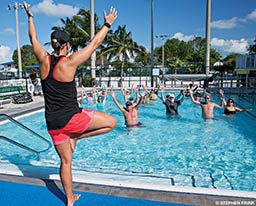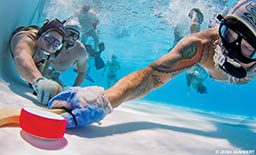A refreshing dip at your local swimming pool can be appealing in the heat of the summer. But the pool is more than just a great place to cool off and socialize — it also offers excellent opportunities to get active and improve your fitness.
Many pools offer group fitness activities to help you get your heart pumping. Group fitness classes can improve motivation, provide accountability and push participants to a greater level of fitness. Plus, group fitness activities are an excellent way to expand your social network. Let’s dive deeper into three different group fitness activities that may be available at your local pool.
Masters Swimming
A Masters swim team is a group of adults, 18 years and older, who get together to swim laps. The swimmers’ ability levels range from beginner to elite — the only prerequisite for becoming a Masters swimmer is knowing how to swim.
By joining a Masters team you will gain access to handwritten swim workouts, a swim coach and on-deck instruction. You’ll also have access to all the pool’s gear — kickboards, fins, masks and snorkels, pull buoys and paddles. The workouts you’ll get will be based on your current ability level and your fitness goals.
Belonging to a Masters team is typically an inexpensive venture. You might pay a drop-in rate or a one-time or monthly fee, either fixed or based on the number of workouts you attend per week.
If you want to take your Masters swimming to the next level, Masters competitions are available. To find a Masters team in your area, visit usms.org.
Water Aerobics
When some people hear water aerobics, they think of exercises geared toward a geriatric population. But you can find water boot camp classes and underwater cycling at many pools. More and more people are realizing the benefits of aquatic activity — benefits divers have known about for quite some time.

The foundation of water aerobics’ effectiveness is the fact that water is roughly 800 times denser than air. The water’s density creates resistance that works our muscles; meanwhile, the water’s buoyancy helps reduce the impact on the body’s joints.
Pools may offer a variety of water aerobics classes; some may be intended for therapeutic purposes, while others might incorporate high-intensity interval training (HIIT). Most classes will include exercises designed to elevate your heart rate.
Many water aerobics programs involve time in both the shallow and deep ends of the pool. Participants in deep-water classes wear a flotation belt to keep them above the surface at all times. Shallow-water classes don’t use these belts, as participants are able to stand on the bottom. Both deep- and shallow-water classes use an array of equipment, including dumbbells, kickboards, webbed gloves, resistance bands and more.
To participate in any type of water aerobics class, you should be comfortable with floating. You don’t necessarily need to know how to swim to participate in water aerobics.
Contact your local pool or visit their website for more information about their water aerobics programs.
Underwater Hockey
Take your breath-hold diving skills to the next level by joining your local underwater hockey team.

As you might imagine, underwater hockey involves two opposing teams, sticks and a puck. It’s played with six players on each team at a time on swimming pool bottoms, typically at 7 to 9 feet deep. A 10-foot-wide goal sits on the bottom at each end of the pool. Players wear a mask, snorkel and fins as well as a water polo cap, a mouth guard and a protective glove on their striking hand. Using curved 10- to 12-inch sticks, players endeavor to outscore their opponents by striking the 3-pound rubber-coated puck, attempting to send it into the opposing team’s goal.
Since all contact with the puck happens on the pool bottom, players constantly rotate between diving down to play and surfacing to get a breath.
Regulation matches feature two short but intense 15-minute halves. Matches and tournaments take place all over the U.S. and the world. For more information about your local underwater hockey team, visit usauwh.org.
No matter what aquatic activities you enjoy, a pool near you likely offers something of interest to you this summer. Use your membership not only to get that refreshing splash but also to improve your dive fitness.
NOTE: To avoid an increased risk of decompression sickness, DAN® recommends that divers avoid strenuous exercise for 24 hours after making a dive. During your annual physical exam or following any changes in your health status, consult your physician to ensure you have medical clearance to dive.